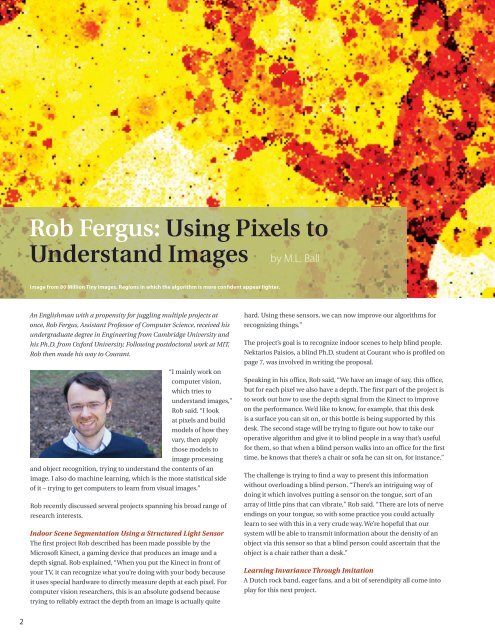Newsletter - Courant Institute of Mathematical Sciences - New York ...
Newsletter - Courant Institute of Mathematical Sciences - New York ...
Newsletter - Courant Institute of Mathematical Sciences - New York ...
You also want an ePaper? Increase the reach of your titles
YUMPU automatically turns print PDFs into web optimized ePapers that Google loves.
2<br />
Rob Fergus: Using Pixels to<br />
Understand Images by M.L. Ball<br />
Image from 80 Million Tiny Images. Regions in which the algorithm is more confident appear lighter.<br />
An Englishman with a propensity for juggling multiple projects at<br />
once, Rob Fergus, Assistant Pr<strong>of</strong>essor <strong>of</strong> Computer Science, received his<br />
undergraduate degree in Engineering from Cambridge University and<br />
his Ph.D. from Oxford University. Following postdoctoral work at MIT,<br />
Rob then made his way to <strong>Courant</strong>.<br />
“I mainly work on<br />
computer vision,<br />
which tries to<br />
understand images,”<br />
Rob said. “I look<br />
at pixels and build<br />
models <strong>of</strong> how they<br />
vary, then apply<br />
those models to<br />
image processing<br />
and object recognition, trying to understand the contents <strong>of</strong> an<br />
image. I also do machine learning, which is the more statistical side<br />
<strong>of</strong> it – trying to get computers to learn from visual images.”<br />
Rob recently discussed several projects spanning his broad range <strong>of</strong><br />
research interests.<br />
Indoor Scene Segmentation Using a Structured Light Sensor<br />
The first project Rob described has been made possible by the<br />
Micros<strong>of</strong>t Kinect, a gaming device that produces an image and a<br />
depth signal. Rob explained, “When you put the Kinect in front <strong>of</strong><br />
your TV, it can recognize what you’re doing with your body because<br />
it uses special hardware to directly measure depth at each pixel. For<br />
computer vision researchers, this is an absolute godsend because<br />
trying to reliably extract the depth from an image is actually quite<br />
hard. Using these sensors, we can now improve our algorithms for<br />
recognizing things.”<br />
The project’s goal is to recognize indoor scenes to help blind people.<br />
Nektarios Paisios, a blind Ph.D. student at <strong>Courant</strong> who is pr<strong>of</strong>iled on<br />
page 7, was involved in writing the proposal.<br />
Speaking in his <strong>of</strong>fice, Rob said, “We have an image <strong>of</strong> say, this <strong>of</strong>fice,<br />
but for each pixel we also have a depth. The first part <strong>of</strong> the project is<br />
to work out how to use the depth signal from the Kinect to improve<br />
on the performance. We’d like to know, for example, that this desk<br />
is a surface you can sit on, or this bottle is being supported by this<br />
desk. The second stage will be trying to figure out how to take our<br />
operative algorithm and give it to blind people in a way that’s useful<br />
for them, so that when a blind person walks into an <strong>of</strong>fice for the first<br />
time, he knows that there’s a chair or s<strong>of</strong>a he can sit on, for instance.”<br />
The challenge is trying to find a way to present this information<br />
without overloading a blind person. “There’s an intriguing way <strong>of</strong><br />
doing it which involves putting a sensor on the tongue, sort <strong>of</strong> an<br />
array <strong>of</strong> little pins that can vibrate,” Rob said. “There are lots <strong>of</strong> nerve<br />
endings on your tongue, so with some practice you could actually<br />
learn to see with this in a very crude way. We’re hopeful that our<br />
system will be able to transmit information about the density <strong>of</strong> an<br />
object via this sensor so that a blind person could ascertain that the<br />
object is a chair rather than a desk.”<br />
Learning Invariance Through Imitation<br />
A Dutch rock band, eager fans, and a bit <strong>of</strong> serendipity all come into<br />
play for this next project.

















